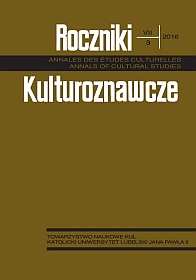Robots, Slaves, and the Paradox of the Human Condition in Isaac Asimov’s Robot Stories
Abstrakt
Roboty, niewolnicy i paradoks ludzkiej kondycji w opowieściach o robotach Izaaka Asimova
Robotników i roboty łączy ze sobą intencja do posłuszeństwa rozkazom, która jest powodem mojej propozycji analizy kilku opowieści o robotach autorstwa Isaaca Asimova. Realizowanie programu w trakcie wykrywania i rozwiązywania problemów oraz wypełniania zadanych instrukcji – to wszystko czyni robota doskonałym niewolnikiem. Trzy Prawa Robotyki Asimova stanowią formalny warunek możliwości pracy w społeczeństwie utrzymującym roboty, tak samo jak niewolnicze prawa w koloniach brytyjskich Ameryki miały zapewnić utrzymanie efektywności niewolnictwa poprzez zamknięcie niewolników w miejscach ich pracy. Poprzez ustanowienie struktury rozkazu potrzebnej w utrzymywaniu i demontowaniu pracującego systemu androidy Asimova objawiają niemożliwość obydwu – robotów i niewolników. Trzy Prawa i ich konsekwencja, czyli gwarancja ochrony, rozkazu i operacji, prawdopodobnie nie mogą działać wobec podmiotów będących oddzielnie panami lub niewolnikami. Te Prawa są paradoksalnym zestawieniem w konsekwencji czego niewolnictwo staje się niemożliwe z punktu widzenia logiki.
Bibliografia
Ady, John, Anthony Benezet, and John Drinker. The Case of Our Fellow-Creatures, the Oppressed Africans Respectfully Recommended to the Serious Consideration of the Legislature of Great-Britain. London, Philadelphia: reprinted by Joseph Crukshank, 1784.
Anderson, Susan Leigh. “Asimov’s ‘Three Laws of Robotics’ and Machine Metaethics.” AI & Society 22, no. 4 (2008): 477–93, doi: 10.1007/s00146-007-0094-5.
Anderson, Susan Leigh. “Asimov’s ‘Three Laws of Robotics’ and Machine Metaethics.” In Science Fiction and Philosophy: From Time Travel to Superintelligence, edited by Susan Schneider, 259–76. Chichester: Wiley-Blackwell, 2009).
Asimov, Isaac. Robot Dreams. New York: Ace Books, 2004.
Asimov, Isaac. The Complete Robot. London: HarperCollins, 1995.
Blum, Paul Richard. “The Immortality of the Soul,” in The Cambridge Companion to Renaissance Philosophy, edited by James Hankins, 211–33. Cambridge: Cambridge University Press, 2007.
Clark, Andy, and David J. Chalmers. “The Extended Mind,” Journal (Paginated), Analysis, (1998), http://cogprints.org/320/
Clarke, Roger. “Asimov’s Laws of Robotics: Implications for Information Technology.” In Machine Ethics, edited by Michael Anderson and Susan Leigh Anderson, 254–84. New York: Cambridge University Press, 2011.
Gisondi, Marcello. “Ma gli androidi leggono Kant? Le leggi della robotica: un possibile percorso epistemologico dalla letteratura al diritto.” ISLL Papers The Online Collection, 209-216, 6 (2013), https://www.academia.edu/3122766.
Goodall, Jane. “Transferred Agencies: Performance and the Fear of Automatism.” Theatre Journal 49, no. 4 (1997): 441–53.
Grau, Christopher. “There Is No ‘I’ in ‘Robot’: Robots and Utilitarianism.” In Machine Ethics, edited by Michael Anderson and Susan Leigh Anderson, 451–63. New York: Cambridge University Press, 2011.
Hassler, Donald M. “Some Asimov Resonances from the Enlightenment.” Science Fiction Studies 15, no. 1 (March 1988): 36–47.
Horáková, Jana, and Jozef Kelemen. “Artificial Living Beings and Robots: One Root, Variety of Influences,” Artificial Life and Robotics 13, no. 2 (March 8, 2009): 555–60, doi: 10.1007/s10015-008-0502-z.
Klüver, Jürgen, and Christina Klüver. Social Understanding: On Hermeneutics, Geometrical Models and Artificial Intelligence. New York: Springer, 2011.
Martín Alegre, Sara. “La Humanización del Robot en El Hombre del Bicentenario: Del relato de Isaac Asimov a la adaptación cinematográfica de Chris Columbus y Nicholas Kazan,” Seminario Tecnología y Posthumanidad, 2002, 1–5 http://ddd.uab.cat/record/113501 (accessed September 28, 2015).
McCauley, Lee. “AI Armageddon and the Three Laws of Robotics.” Ethics and Information Technology 9, no. 2 (August 23, 2007): 153–64, doi:10.1007/s10676-007-9138-2.
Science Fiction and Philosophy: From Time Travel to Superintelligence, edited by Susan Schneider. Chichester: Wiley-Blackwell, 2009.
Short, Sue. “The Measure of a Man? Asimov’s Bicentennial Man, Star Trek’s Data, and Being Human.” Extrapolation 44, no. 2 (2003): 209–23.
Smith, Cedric M. “Origin and Uses of Primum Non Nocere—Above All, Do No Harm!” Journal of Clinical Pharmacology 45, no. 4 (2005): 371–77.
Vaart, Elske, and Charlotte K. Hemelrijk. “‘Theory of Mind’ in Animals: Ways to Make Progress.” Synthese: An International Journal for Epistemology, Methodology and Philosophy of Science 191, no. 3 (February 1, 2014): 335–54.
Zunt, Dominik. “Who Did Actually Invent the Word ‘Robot’ and What Does It Mean?” July 27, 2013, http://web.archive.org/web/20130727132806/http://capek.misto.cz/english/robot.html (accessed October 4, 2015). Czech text at http://blog.abchistory.cz/cl97-karel-capek-o-slove-robot.htm (accessed October 4, 2015).





